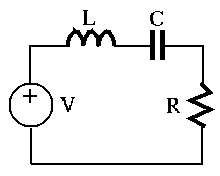Next: Kirchhoff's Laws Up: Chapter 1: Basic Quantities Previous: Energy Dissipation/Storage in R,
 and a mass
and a mass  can be
described by the following equation (Newton's second law
can be
described by the following equation (Newton's second law  ):
):
 i.e. i.e. |
(61) |
 is the displacement of the mass (horizontal) and
is the displacement of the mass (horizontal) and
 (
( is the compliance of the spring).
is the compliance of the spring).
 and an inductor
and an inductor  in parallel can be described by:
in parallel can be described by:
 |
(62) |
 is the voltage across both components, and
is the voltage across both components, and  and
and  are currents through
are currents through  and
and  , respectively.
, respectively.

As


 i.e. i.e. |
(63) |
To find the homogeneous solution of the differential equation above
(for either the mechanical or electrical system), we assume


 i.e., i.e., |
(64) |
 and
and
 |
(65) |
 , i.e., the potential energy stored in the spring
is zero, the velocity
, i.e., the potential energy stored in the spring
is zero, the velocity
 ,
i.e., the kinetic energy is maximal. On the other hand, when the
displacement is
,
i.e., the kinetic energy is maximal. On the other hand, when the
displacement is
 , i.e., the potential
energy stored in the spring is maximal, the velocity
, i.e., the potential
energy stored in the spring is maximal, the velocity
 , i.e., the kinetic energy is zero.
, i.e., the kinetic energy is zero.
 , i.e., the
energy stored in the capacitor is zero
, i.e., the
energy stored in the capacitor is zero
 ,
,
 , i.e.,
the energy stored in the inductor
, i.e.,
the energy stored in the inductor
 is maximal. On the other
hand, when
is maximal. On the other
hand, when
 , i.e., the energy stored in the
capacitor is maximal,
, i.e., the energy stored in the
capacitor is maximal,
 ,
i.e., the energy stored in the inductor is zero.
,
i.e., the energy stored in the inductor is zero.
However, when a dash-pot (causing friction proportional to speed 
 |
(66) |
 |
(67) |

The corresponding solution of the DEs will be decaying sinusoidal, indicating the dissipation of the energy in the system.
Consider the power in the RCL electrical system:
 |
(68) |
![$\displaystyle w=\int_0^t P(\tau) d\tau=v(t) [Q(t)-Q(0)]=Cv^2(t)$](img261.svg) |
(69) |
 and
and
 . On the other hand,
as we also know the energy stored in
. On the other hand,
as we also know the energy stored in  is
is
 , we see that
half of the energy is consumed (dissipated/stored) in the rest of
the circuit (
, we see that
half of the energy is consumed (dissipated/stored) in the rest of
the circuit ( and
and  ). This is always the case independent of
the system parameters. When the input voltage is DC
). This is always the case independent of
the system parameters. When the input voltage is DC  , the
current at the steady-state is zero and the energy stored in
, the
current at the steady-state is zero and the energy stored in  is
is
 , i.e., half of the energy from the source is dissipated
by
, i.e., half of the energy from the source is dissipated
by  . However, when
. However, when  , the energy is converted back and forth
between
, the energy is converted back and forth
between  and
and  as described above.
as described above.